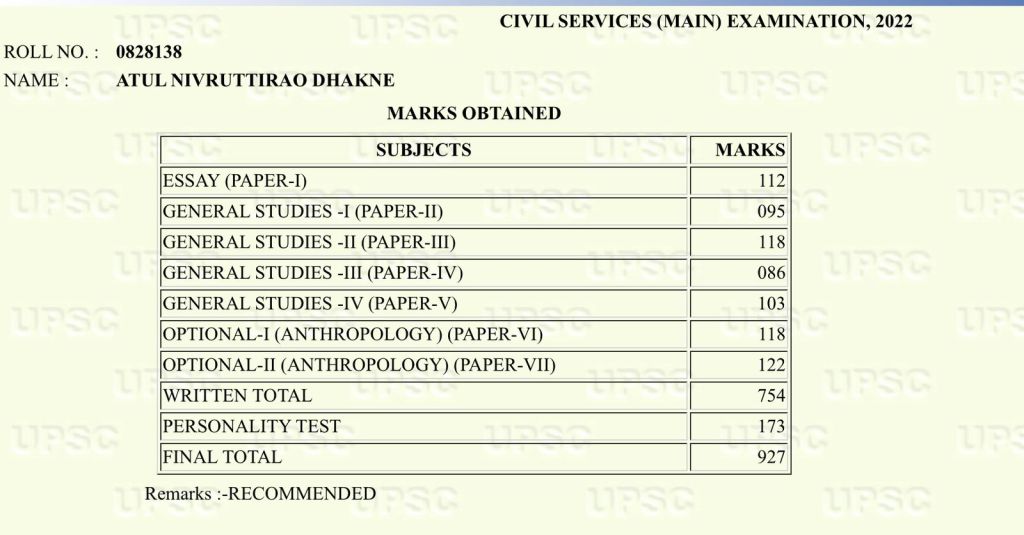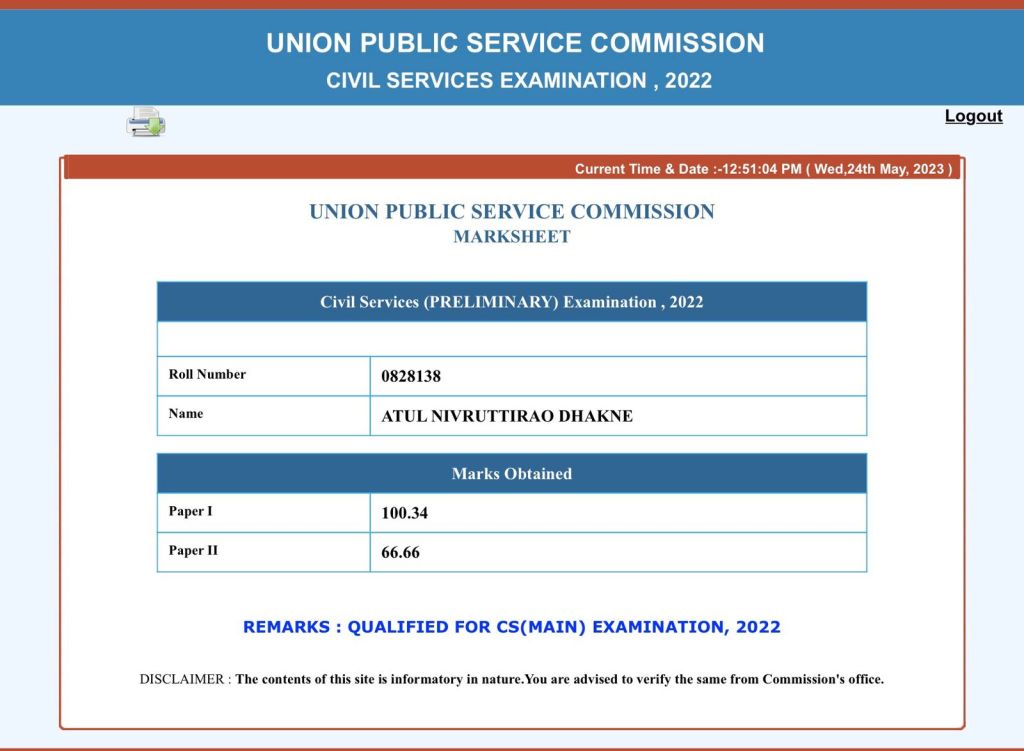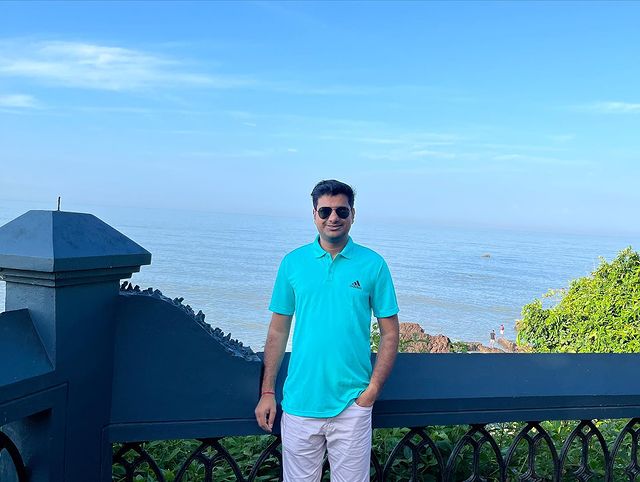
I’m Dr. Atul Nivruttirao Dhakne. I went to BJ Govt Medical College in Pune and got my MBBS degree. I am from the Maharashtra district of Beed. I am also the founder and president of Lift For Upliftment, which is the first non-profit organisation to offer free offline and home coaching for NEET to people who are poor. Over 200 of our students have become doctors in the last 7.5 years. I also teach NEET students math and biology. Visit www.lfupune.in to find out more.


Table of Contents
A different way to look at CSE Prelims (GS)
People say that the UPSC CSE prelims are the most uncertain part of the test. But I would like to respectfully disagree with this idea. I think that the topics asked on the GS preliminary paper have been the same for the past 10 years. This theme-based method helped me pass three prelims in a row (2020, 2021, and 2022) after failing the first two (2018 and 2019).
Thematic Approach for the GS Prelims
Themes are the subtopics that are often asked about on GS exams. Even though the way questions are asked and the way answers are given may change (like in the 2023 prelims), the themes haven’t changed. For example, we have questions about the Breton Woods Institution in economics every year, and this keeps happening.
About 65–70% of the paper is about these ideas. And if you look at the last five years, it’s never been more than 50%. So, doing these topic studies really helped me get past the GS cut-off plus 15 points in 2021 and 2022, even though I didn’t study current events.
How do I look for themes?
The answer is through studies from the previous year. I used the actual question papers that were available as pdfs on the UPSC website instead of a so-called “ready-made” book of solved prelims papers. It’s because the writers of those books write about how they feel about the questions, not how they should be evaluated. Themes can be found by looking at 3 to 4 old works in 3 different ways:-
1) Static versus present questions
2) In a steady question, figuring out which subject the question comes from.
3) Once we’ve found the subject, we have to find that question in the static source book we used. Through that, we can find the SUBTOPIC, which is where the question comes from, and make a note of it.
If you do the above practise for 3 or 4 papers, you’ll see right away that some subtopics come up over and over again. Your main ideas are just these subtopics that keep coming up. This can help us find at least 30–40 ideas that are important enough to have 55–65 questions about them.
How do themes help?
1. To prioritise our learning. More important things that can be known for sure should come first. (For example, the economy section has 18–22 questions, and 70% of them can be answered based on statics. This makes the economy section the most important. Then Polity, 10 or more questions with Laxmikant as a set source)
2. To put in order the subtopics that need to be reviewed for a certain subject. For example, the Banking Sector topic has two or more questions, some of which are set (such as questions about inflation and the amount of money in the market).
3. To make subjects like ancient and mediaeval history, art and culture, and science and technology that are hard to predict into ones that are easy to predict. Themes like the Mughals (their government, land tax system, building, and paintings) help us identify which subtopics keep coming up so we can at least get ready for them. The theme of the Vijayanagar Empire is another one. Almost no preliminary paper doesn’t have at least one question about Vijaynagar. So instead of complaining that the subject is uncertain, we can at least be sure that some themes will come up again and again. In the same way, science and technology topics like ISRO, the missile programme, IVF technology, rDNA technology, vaccines, viral diseases, and so on, can be studied ahead of time and specific questions can be answered in the test.
4. Know what the UPSC wants from a certain theme. For example, a topic like inflation or the amount of money needs mental clarity. For animals in the environment, we need to know where they live, what their IUCN standing is, how they find food, etc. Also, even if a new animal is asked about, the question will still talk about animals that have already been asked about, which can help us solve the question. In mediaeval history, another example, the UPSC wants us to know about an empire’s administration, land revenue system, associated religion/Bhakti saint, architecture, special cultural features (paintings of Mughals, etc.), and connection with the British conquest of India (Mughal emperors would meet Captain Hawkins, give orders, etc.).
5. Don’t worry about our GS paper: You won’t be distracted by the market’s attempts to create confusion because you will notice that some questions and themes come up over and over again. Remember that having confidence is the key to doing well on Prelims, and that confidence comes from doing objective research and working hard.
6. Don’t let us get distracted by big news stories: By looking at past papers, you can also see what kinds of questions about current events were asked on the test, so you can only read those. Also, current events never make up more than 30-35 questions, so it’s clear that you don’t need to know about them to pass prelims (except for business and science & tech). So, if this is so clear, why should you have spent more than 70% of your time in the last two months reading about big news stories? I never did that. In the last few months, I spent more than 90% of my time reviewing basic material and absolutely none on current events (more on the “Myth of Current Events” below).
What I’ve learned about giving practise tests
Why mock tests are important?
Reviewing topics that don’t change, like government, history, the economy, the environment, etc. I don’t see what else it has to do with. This is because (even before the disastrous 2023 prelims) none of the mock tests fit the level and style of the UPSC exam. And the way questions are asked in mock tests for training makes a candidate want to study for those tests instead of the UPSC exam. An aspirant may get used to the language used in mock tests, but he should be used to the vocabulary used by the UPSC. Also, mocks of private teaching don’t stick to the themes. Some coaching even asks questions about facts (GS SCORE, etc.), while others ask about current events from the same day (Forum IAS simulator tests) or about unrelated topics like defence exercises (no questions have been asked about defence exercises in the last 12 years of UPSC CSE prelims), or they ask questions from their own current events magazine (Vision Abhyas). I’ve seen people get 130 or more on the Vision Abhyas test but less than 80 on the UPSC Prelims test in the same month.
So, my plan was to solve at least 5–10 old PAPERS (in 2–hour exercise mode) in the last 15 days before the test. Even if we already know some of the answers, we get good practise with UPSC language and find out where we need to work on our weak spots.
So, teaching tests can be used to help people remember things for up to 30 days. Strictly speaking, you shouldn’t pay attention to how well you did on a test. Instead, you should look at your mistakes and remember them. Then, to clean up the way you prepare for tests, you can do 10 previous year questions in simulation mode every day and look at where you went wrong.
The myth of current affairs
I think that recent events are what make an aspirant’s UPSC syllabus so long. For static, there aren’t more than 1500 pages in 15 to 18 books, and they make up 70% of the source material’s weight. But a year’s worth of current events magazines has 1200–1500 pages, but it only counts for 30%, and we don’t even know where that information came from. This helped me come up with the ratio of static study time to active study time, which is 4:1. So, if I’m going to study for 5 days, I’ll only have 1 day for current events and 4 days for set events. During the last two months of prelims, this percentage is followed to the letter. This will help you get 80% right on questions from static subjects like politics, economics, the environment (if you read the PMF Environment book), and modern history (80% of questions come from the range). This subjects includes about 45+ questions in prelims.
I also think that one of the reasons candidates miss the cut-off by 1–10 points is that they don’t study statics very hard in the last 10 days before the test, even though they worked very hard on their prelims. You don’t have to blame the current events questions if you want to find out where you went wrong.
By looking at past year’s tests, we can say for sure that the only current events you need to know about are the economy and science and technology, and even then, only on certain themes.
Some teaching or portal sites make up stories about the people who ask them questions about current events. I feel like a spoonful of water from an ocean is useful. Also, we need to know if the questions about current events were important for passing the prelims or not.
Also, some teaching valas find the answers to static questions in the newspaper The Hindu. But if my stability is good, I don’t see why I should spend a lot of time tracking down such news. This is especially true for topics like art, history, and the environment.
So, we can say that current events can help us in the mains (especially in GS3 and IR), but they aren’t a must-have to pass the Prelims.
My take on 2023 prelims
People say that 2023 prelims will change the game. Yes, but only for people who use ways to get rid of waste. People who took a general approach and knew a lot about static still did well on the GS paper (I won’t talk about the CSAT).
You can look at every question asked in this paper to see if what I said is true. The only thing that has changed is the way questions are asked. And I had already figured out that there is no quick fix for politics or the business. We need to know a lot about these things. And this helps someone who wants to answer questions about politics and the business correctly. So, yes, using a theme for 2023 prelims also works!


![UPSC CSE Topper Mains Answer [Part 2] images-2023-06-17T192027.770](https://iasbio.com/wp-content/uploads/2023/06/images-2023-06-17T192027.770-150x150.jpeg)













